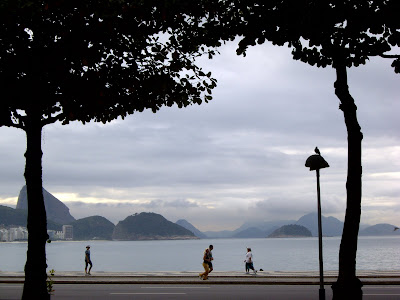
Last week I was fortunate enough to visit 3 wonderful Brazilian cities: Brasilia, Sao Paulo and Rio de Janeiro. In my opinion each of these cities is unique and special in its own right, and they all have lovely and helpful people, who made my trip that much more enjoyable. Upon my return, I was eager to tell everyone about the wonderful architecture of Brasilia and the sophistication of Sao Paulo, yet I noticed people had a marked interest for Rio de Janeiro, they wanted to know absolutely everything about this legendary metropolis. So it is for this reason that I’ve decided to dedicate my first post to this marvelous city by the sea.
So how do I begin to describe this culturally rich and complex city? How can I, a mere passerby accurately portray this cluster of more than 10 million souls interacting daily, existing side by side. More importantly have I understood the soul of the city, that unique energy that makes Rio de Janeiro different from any other? Rio de Janeiro is a city of contrasts, not only geographically but economically, and for this reason it is many things to different people. So should I talk about the glamorous Rio filled with luxurious condos overlooking the sea and private yachts docked? Or should I talk about the populous favelas (slums) tucked in the surrounding hills, under the watchful eye of Christ the Redeemer? In reality, all I can do is describe Rio through a pair of fresh, uncorrupted eyes that are taking in all the sights, energy and people for the very first time.
As I’m preparing to deliver my account of this city, many scenes flash through my mind: The mellow feel of Copacabana beach, right there in the heart of the city, with its street vendors and sun worshipers; the hip and youthful atmosphere of Ipanema beach with its crowd of pretty, young things enjoying the surf and the social scene; the busy downtown where it seems some actual work gets done; the Pao de Azucar, the landmark hill that offers an incredible view of all the city; the spiraling road up to the Corcovado, with its many quaint houses where poor, rich, and middle class fit seamlessly; the North side, the less glamorous side of town, where the privileged few of Copacabana, Ipanema, and Leblon are left far behind to give way to the sobering reality of most of its inhabitants. So, is Rio essentially the sum of vastly different areas? Is it precisely the contrasts that define Rio or is there one common denominator that transcends beyond geography and economic class?
My mind is going in all directions trying to find a concise answer to these questions, when all of a sudden a solitary phrase floats through my head: “No mar estava escrita uma cidade”, which roughly translates to: “there was a city written in the sea”. I first encountered this phrase in my initial walk through Copacabana; there it was, engraved right next to the statue of its author, the great Brazilian poet Carlos Drummond de Andrade. I thought it was so simple and yet so beautiful. Now I realize that there was much more to this line, in 6 words it captured the essence of Rio de Janeiro. Like planets around the sun, the lives of cariocas (Rio natives) revolve around the ocean. The sun has just come up and the boardwalk of Copacabana is already filled with people, whether it’s for a spirited stroll or jog, a bike ride, some early surfing, or a quick splash in the water. As the day progresses the beaches are never lonely, its seems as if cariocas are pulled to the sea in search of life, in search of fuel for their souls. In the sand, class lines fade, for the sun and the sea do not know of inequality, they are noble, existing only to restore the hearts and bodies of a people whose lives are written in the sea.




No comments:
Post a Comment